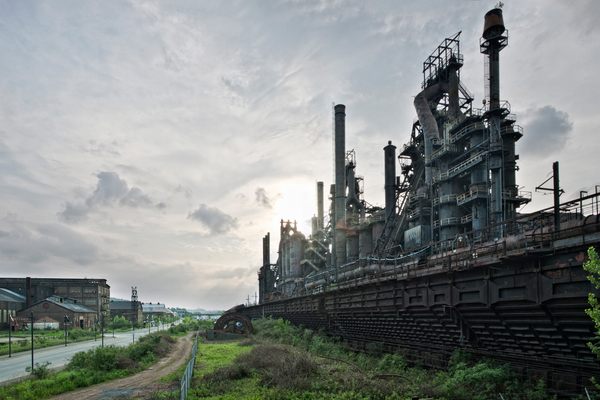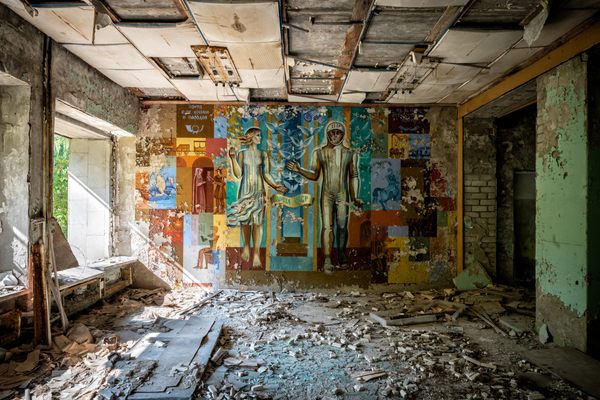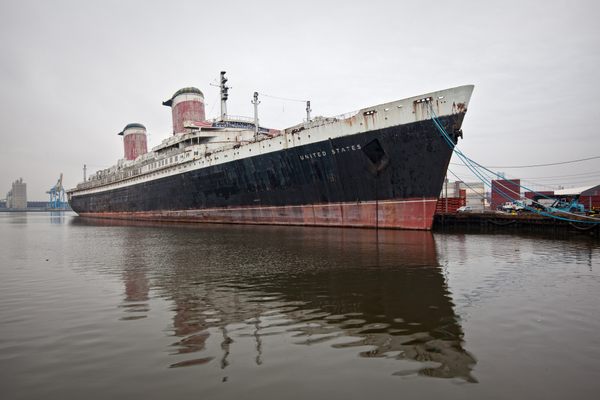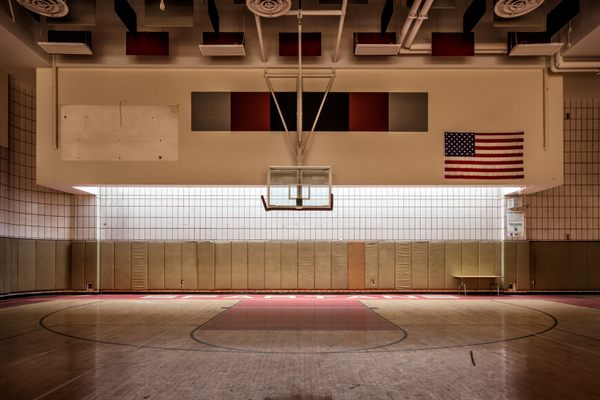
The Brief Rise and Steep Fall of a New Orleans Amusement Park
Nearly 20 years after Hurricane Katrina, the abandoned Six Flags that became a symbol of the city still bears deep scars.

There’s something primordial about the ruins of Six Flags New Orleans. Overgrown with Smilax thorns that loop around the skeletal remains of kiddie rides and home to alligators and boars, the former amusement park feels less like a real-world location and more like a figment from a half-forgotten nightmare. Faded, moldy Looney Tunes cartoon characters peer out with horribly misplaced cheer underneath sagging, graffiti-splattered concessions stands. Rides that once evoked laughter and delighted screams now slump defeatedly, a grim reminder of the tragedy that befell an entire city nearly two decades ago.
The peaks of roller coasters jut out from the landscape against the darkened night sky like dinosaur bones. They’re framed against the yards of neighbors who thought their proximity to such an iconic attraction would increase property values. Instead, those values plummeted further with every year the park was left abandoned.


These ragged wounds, juxtaposed against the remaining fragments of a venue whose upbeat marketing slogan “It’s playtime!” was symbolic of the entire American concept of consumerized fun, evoke a deep melancholy that is difficult to articulate. Like all abandoned places, to be in Six Flags New Orlean’s presence is to stand at the focal point of a tragedy that is too far-reaching to quantify: it is the spot where thousands of dreams fractured and broke. Planners and city officials hoped that Six Flags New Orleans would be an economic boon for its owners and the surrounding homes and businesses. Workers depended on Six Flags for their jobs and financial security. Even the fond memories of families who visited the amusement park during its heyday are now warped by the horrible fate that befell it. Most significantly, there’s the still-fresh grief for the nearly 1,400 lives lost in the catastrophe that closed the park forever.
Opened as Jazzland on May 20, 2000, and closed as Six Flags New Orleans in 2005, this park has been abandoned for longer than it was ever operational. As with much of the damage wrought by Hurricane Katrina, moving on has proved more challenging than outside observers might anticipate.

When the beloved Art-Deco Ponchartrain Beach theme park closed in 1983 after 55 years of operation, the closest amusement park to New Orleans was Houston’s Astroworld about 350 miles away. Real estate developers Tom and Dian Winingder had grand visions for building the city’s next amusement park on 220 acres of swampland they owned. Jazzland, as Tom and Dian pitched it, would honor the area’s history, music, and even the former Ponchartrain Beach amusement park. But it was a tough sell. Investors expressed interest, then backed out, again and again over the course of a decade. By 1997, the Winingders had finally accumulated enough money to break ground on the project, but before it was even completed, the leading investor sold the park to Greek conglomerate Alfa Alfa Holdings with only two months until the grand opening.
Though Jazzland opened with great fanfare and a solid first season, attendance dropped sharply the next year – partly due to the bewildering lack of shaded areas, canopies, and water rides to help visitors cool off from the sweltering summer heat. When Alfa went bankrupt in 2002, Six Flags snatched up the lease and added over $20 million in improvements, including much-needed shade and Warner Brothers-themed rides. The park reopened as Six Flags New Orleans for the 2003 season, but the company that now owned it was in dire financial straits. Astroworld was closed and demolished in 2005, and the underperforming Six Flags New Orleans would likely have been closed or sold off shortly afterward.
Instead, something much worse happened. On August 25, the tropical depression that would become Hurricane Katrina made landfall in Florida, gaining speed and strength as it barreled toward New Orleans. The staff at Six Flags New Orleans, which had closed for the weekend on August 21, had little time to protect themselves, let alone the park. New Orleans, which is below sea level, was protected by a series of levees up to 23 feet high, but the defenses proved no match for the Category 5 hurricane. Less than a mile and a half from Six Flags, water from Lake Ponchartrain overflowed and poured into the city, submerging roughly 80 percent of New Orleans. Though Six Flags was built on a four-foot elevated platform to reduce flooding, the drainage pumps quickly failed and the property was inundated in up to seven feet of saltwater, which remained for over a month.


After the water eventually receded, cleanup would prove astronomically expensive. Most wooden structures were a complete loss, concessions and retail merchandise were destroyed, and the structural integrity of the rides had been compromised by weeks in brackish water. Fixing these issues would require an investment Six Flags had no intention of making for a park that had already been failing to meet expectations. Instead, they began a long and costly battle with the city to terminate their 75-year lease. Both the city and Six Flags were hoping for an insurance payout that never came—many of the park’s insurance policies expressly excluded damage caused by flooding. The city of New Orleans was essentially left holding the bag for somewhere between an estimated $500 million to $1 billion in demolition and cleanup costs.
As years passed, proposals for reusing the site materialized and then vanished: developer Southern Star’s plans for a Nickelodeon Universe water park fell through in 2009, and subsequent plans to build a hotel, sports complex, and movie studio bottomed out in 2011 when Southern Star failed to start the process of taking possession of the property. Jazzland Paidia Company, a company founded on the dream of reopening Jazzland as an amusement park, was ignored by the city. Ideas to repurpose the property as a power plant or outlet mall fizzled.
The Bayou Phoenix company was granted permission to redevelop the 227-acre property in 2021 and took control of the property in 2023. With estimated costs ranging between $500 million and almost $1 billion, the project to convert the site into “a multi-use space that includes a sports complex for kids, hotels, restaurants, water parks, an entertainment center, and a clearwater beach” seems monumental. Projects of such scale often move very slowly, and news since late 2023 has been scarce. Demolition is scheduled to begin by late summer, and while I find myself oddly attached to the places I photograph, I’m hopeful that Bayou Phoenix’s efforts will be successful and the healing process for the area can finally begin.


For the moment, though, the battered amusement park still stands. Even when I photographed it in 2016, it was covered in spray paint and battered by vandals. As I fought through the underbrush and thorns, I was aware I was in a gravesite of sorts. The part of the park that had once stood as a beacon for the nebulous concept of fun was fading into the weeds, replaced by a far more visceral representation of despair.
Outsiders can question the wisdom of trusting levees and building below sea level, or even rebuilding on a site ravaged by one of the costliest and deadliest disasters in modern American history. But we all live below sea level in one way or another. The stability of everyone’s life is perched precariously atop a series of factors we don’t often know or control. On a long enough timeline, everyone’s luck runs out. True, most of our personal catastrophes aren’t so spectacular, but if we survive them, we have to rebuild sooner or later.
Much as I’d selfishly like to see Six Flags remain as it is forever as a memorial of what once was and what could have been, the city of New Orleans deserves to move on and begin the renewal process. Though, as a concept, I like the idea of having a massive abandoned amusement park in my backyard, the reality of looking at the twisting spines of roller coasters that will never run again every time I return home haunts me. It’s good to visit gravesites, to remember the past and honor those we lost. But living in one is too much, even for me.


To see the rest of the photos and read more about the history of Six Flags New Orleans, visit the Abandoned America website. You can also listen to the Abandoned America podcast interview with Jake Williams, director of the documentary Closed For Storm.
Matthew Christopher is a writer and photographer who has explored abandoned locations across the globe for two decades, chronicling the lost landmarks in our midst. You can find more of his work on his website Abandoned America or listen to his Abandoned America podcast.















Follow us on Twitter to get the latest on the world's hidden wonders.
Like us on Facebook to get the latest on the world's hidden wonders.
Follow us on Twitter Like us on Facebook